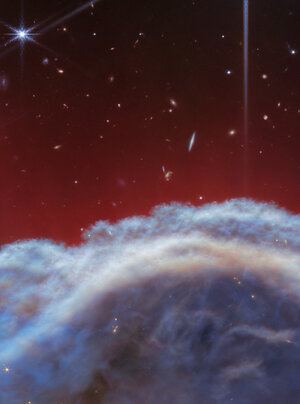

Webb studies the Orion Nebula
An international team of scientists have used data collected by the NASA/ESA/CSA James Webb Space Telescope to detect a molecule known as the methyl cation (CH3+) for the first time, located in the protoplanetary disc surrounding a young star. They accomplished this feat with a cross-disciplinary expert analysis, including key input from laboratory spectroscopists. The vital role of CH3+ in interstellar carbon chemistry has been predicted since the 1970s, but Webb’s unique capabilities have finally made observing it possible — in a region of space where planets capable of accommodating life could eventually form.
This graphic shows the area, in the centre of the Orion Nebula, that was studied by the team. The nebula lies about 1350 light-years from Earth. The largest image, on the left, is from Webb’s NIRCam instrument. On the right, the telescope is focused on a smaller area, where the team have used Webb’s MIRI instrument to add more depth to their study. A total of eighteen filters across both the MIRI and NIRCam instruments were used in these images, covering a range of wavelengths from 1.4 microns in the near-infrared to 25.5 microns in the mid-infrared. The detailed coverage was necessary for the team to study the light from protoplanetary discs, and analyse the unique features revealed by Webb using spectroscopy from its MIRI and NIRSpec instruments.
The region captured here in breathtaking detail by Webb is a part of the Orion Nebula known as the Orion Bar. It is an ionisation front, where energetic far-ultraviolet light from the Trapezium Cluster — located off the upper-left corner — interacts with dense molecular clouds. The energy of the stellar radiation is slowly eroding the Orion Bar, and this has a profound effect on the molecules and chemistry in the protoplanetary discs that have formed around newborn stars here.
At the very centre of the MIRI area is an ionised star-protoplanetary disc system, or proplyd, named d203-506. The pullout at the bottom right displays a combined NIRCam and MIRI image of this young system. Its extended shape is due to pressure from the harsh ultraviolet radiation striking it. The first clear images of proplyds in the Orion Nebula were obtained by the NASA/ESA Hubble Space Telescope, including d203-506. Now Webb’s extended infrared vision adds to the picture, as the team of astronomers were able to confirm that the methyl cation molecule is present in this very proplyd.
[Image description: An image made of three panels. The largest on the left shows the NIRCam image of a nebula with two bright stars. A skewed box in the top-right points to a second panel on the right, with a MIRI image of that area. A tiny box in the centre of that panel is blown up in a third panel below, with a zoomed-in, combined MIRI and NIRCam image of a yellow and orange blob.]





